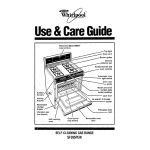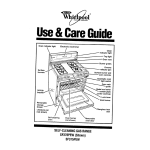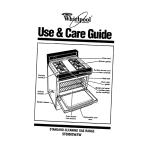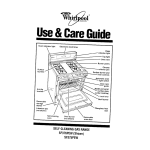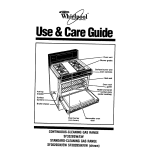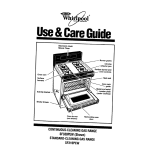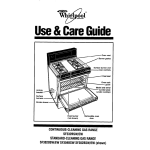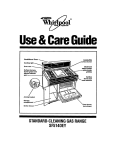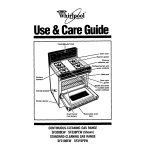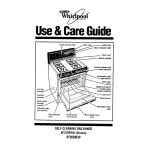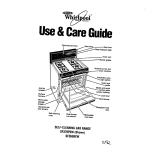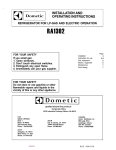Download Whirlpool SF376PEP Specifications
Transcript
YthfJ 3 21 Use& CareGuide Oven indicator \ light oven controls LANKET-O-FLAME lot shown) -I ‘- seal I / Self-cleaning oven Oven burner Removable door SELF-CLEANING GASRANGE SF376PEP oven Contents Page Important Safety Instructions ...................................... .3 Using Your Range ........................... .6 Using the surface burners .............. .6 Setting the clock.. ............................ 7 Using the Minute Timer .................. .8 Using the oven controls .................. .9 Using the automatic MEALTIMER’” clock .......................................... 11 The oven vent ............................... 13 The storage drawer ...................... .13 Caring For Your Range ................. .14 Control panel and knobs ............... 15 Surface burner grates .................. .16 Surface burners ............................ 17 Removable cooktop ..................... .17 Removable oven door ................... 18 Using the Self-Cleaning cycle ....... .I9 Cleaning tips ................................. 23 Using and replacing the light bulbs 24 If You Need Service Or Assistance ................................ .26 Whirlpool Range Warranty ............ .28 01989 Whirloool Corooration Thank you for buying a Whirlpool appliance. Please complete and mail the Owner Registration Card provided with this product. Then complete the form below. Have this information ready if you need service or call with a question. l Copy model and serial numbers from plate (located as shown) and purchase date from sales slip. l Keep this book, the Cooking Guide and sales slip together in the Literature Pac. Model Number Serial Number Purchase Service Company Phone Number You are responsible for: Installing and leveling the range on a floor strong enough to support its weight, and where it is protected from the elements. (See the Installation Instructions.) l Making sure the range is not used by anyone unable to operate it properly. . Properly maintaining the range. l Using the range only for jobs expected of a home range. l Remove the Consumer Buy Guide label. It will be easier to remove before the range is used. To remove any remaining glue: l Rub briskly with thumb to make a ball, then remove. or l Soak area with liquid hand dishwashing detergent before removing glue as described above. Do not use rubbing alcohol or flammable or toxic solvents, such as acetone, gasoline, carbon tetrachloride, etc. These can damage the finish. Date ImportantSafetyInstructions Gas ranges have been thoroughly tested for safe and efficient operation. However, as with any appliance, there are specific installation and safety precautions which must be followed to ensure safe and satisfactory operation. l FOR YOUR SAFETY l DO NOT STORE OR USE GASOLINE OR OTHER FLAMMABLE VAPORS AND LIQUIDS IN THE VICINITY OF THIS OR ANY OTHER APPLIANCE. THE FUMES CAN CREATE A FIRE HAZARD OR EXPLOSION. FOR YOUR SAFETY l YOU SMELL GAS: OPEN WINDOWS. DON’T TOUCH ELECTRICAL SWITCHES. EXTINGUISH ANY OPEN FLAMES. IMMEDIATELY CALL YOUR GAS SUPPLIER. l IF 1. 2. 3. 4. IMPROPER INSTALLATION, ADJUSTMENT, ALTERATION, SERVICE OR MAINTENANCE CAN CAUSE INJURY OR PROPERTY DAMAGE. REFER TO THIS MANUAL. FOR ASSISTANCE OR ADDITIONAL INFORMATION CONSULT A QUALIFIED INSTALLER, SERVICE AGENCY, MANUFACTURER (DEALER) OR THE GAS SUPPLIER. - IMPORTANT - To the Installer: Please leave this instruction book with the unit. To the Consumer: Please read and keep this book for future reference. . Read all instructions before using the range. l Install or locate the range only in accordance with the provided Installation Instructions. It is recommended that the range be installed by a qualified installer. The range must be properly connected to the proper gas supply and checked for leaks. The range must also be properly connected to electrical supply and grounded. Important Safety Instructions Continued l l l l l l 4 Gas fuels and combustion can result in potential exposure to chemicals known to cause cancer or reproductive harm. For example, benzene is a chemical which is a part of the gas supplied to the range. It is consumed in the flame during combustion. However, exposure to a small amount of benzene is possible if a gas leak occurs. Formaldehyde and soot are by-products of incomplete combustion. Properly adjusted burners with a bluish rather than a yellow flame will minimize incomplete combustion. Do not operate the range if it is not working properly, or if it has been damaged. Do not use the range for warming or heating the room. Persons could be burned or injured, or a fire could start. Use the range only for its intended use as described in this manual. Do not wear loose or hanging garments when using the range. They could ignite if they touch a hot surface burner and you could be burned. Do not touch surface burners, areas near burners or interior surfaces of oven. Areas near surface burners and interior surfaces of an oven become hot enough to cause burns. During use, do not touch, or let clothing or other flammable materials contact surface burners, areas near surface burners or interior surfaces of oven. Other surfaces of the range may become hot enough to cause burns; such as, the oven vent opening, the surface near the vent opening, the cooktop, the oven door and window. Make sure the utensils you use are large enough to contain food and avoid boil-overs and spill-overs. Heavy splattering or spill-overs left on a range can ignite and burn you. Pan size is especially important in deep fat frying. l Turn pan handles inward, but not over other surface burners. This will help reduce the chance of burns, igniting of flammable materials, and spills due to bumping of the pan. l Use only dry potholders. Moist or damp potholders on surface burners may result in burns from steam. Do not let potholder touch surface burners. Do not use a towel or bulky cloth for a potholder. They could catch on fire. l Check to be sure glass cooking utensils are safe for use on the range. Only certain types of glass, glass-ceramic, ceramic, earthenware or other glazed utensils are suitable for ranges without breaking due to the sudden change in temperature. 9 Do not use decorative covers or trivets over the surface burners. l Do not heat unopened containers. They could explode. The hot contents could cause burns and container particles could cause injury. l Grease is flammable and should be handled carefully. Let fat cool before attempting to handle it. Do not allow grease to collect around cooktop or in vents. Wipe spill-overs immediately. l Do not use water on grease fires. Never pick up a flaming pan. Smother flaming pan on range by covering with a well-fitted lid, cookie sheet or flat tray. Flaming grease outside of pan can be extinguished l l l l l l l l l with baking soda or, if available, a multipurpose dry chemical or foam-type extinguisher. Never leave surface burners unattended at high heat settings. A boil-over could result and cause smoking and greasy spill-overs that may ignite. Make sure surface burners are off when you are finished, and when you aren’t watching. Use care when opening oven door. Let hot air or steam escape before removing or replacing food. Always position oven racks in desired location while oven is cool. Do not store flammable materials on or near the range. They could explode or burn. Do not store things children might want above the range. Children could be burned or injured while climbing on it. Do not leave children alone or unattended in area where the range is in use. They should never be allowed to sit or stand on any part of the range. They could be burned or injured. Never use a match or other flame to look for a gas leak. Explosion and injury could result. . Know where your main gas shut off valve is located. . Keep range vents unobstructed. 0 Clean your range regularly. See care and cleaning instructions in this manual. 0 Be sure all range parts are cool before cleaning. l Do not clean door heat seal. It is essential for a good seal. Care should be taken not to rub, damage, or move the seal. Clean only parts recommended in this Use and Care Guide. l Do not use oven cleaners. No commercial oven cleaner or oven liner protective coating of any kind should be used in or around any part of the oven. l Before self-cleaning the oven, remove broiler pan, broiler grid, oven racks and other utensils. Do not use your oven to clean miscellaneous parts. l Do not repair or replace any part of the range unless specifically recommended in this manual. All other servicing should be referred to a qualified technician. l Disconnect the electrical supply before servicing the range. - SAVE THESE INSTRUCTIONS - UsingYour Range Usingthe surface burners Control knobs must be pushed in, then turned to the LITE position. The clicking sound is the ignition sparking. To stop the clicking sound after the burner lights, turn the control knob back to a desired setting. The control knob has stops for HI, MED and LOW, however, it can be set anywhere between HI and OFF. Surface burner marker Surface burner markers The solid dot in the surface burner marker shows which surface burner is turned on by that knob. Until you get used to the settings, use the following as a guide. For best results, start cooking at the high settings; then turn the control knob down to continue cooking. Use LITE to light the burner. After the burner lights, turn control back to a desired setting to stop the clicking of the ignition. Use HI to start foods cooking; to bring liquids to a boil. Use MED to continue cooking or to fry chicken or pancakes; for gravy, puddings and icing; to cook large amounts of vegetables. Use LOW to keep food warm until ready to serve. Set the heat higher or lower within the LOW band to keep food at the temperature you want. NOTE: Do not cook with the control in the LITE position. In case of a prolonged power failure: Surface burners can be manually lighted. Hold a lighted match near a burner and turn the control to the LITE position. After the burner lights, turn the control to the desired setting. l l l l Burn, Fire and Explosion Hazard Burner flame should not extend beyond the edge of the cooking utensil. The flame can burn you and cause poor cooking results. Be sure all control knobs are turned to OFF when you are not cooking. Someone could be burned or a fire could start if a burner is accidentally left ON. If the flame should go out while cooking, or if there is a strong gas odor, turn the burners OFF. Wait five minutes for the gas odor to disappear, before relighting burner. If gas odor is still present, see safety note on page 3. Failure to follow these precautions could result in explosion or fire. Do not attempt to light the oven burner during a power failure. Personal injury could result. Setting the clock Push in and turn the Minute Timer Knob to set the Clock. 1. Push in Minute Timer Knob and turn clockwise until clock shows the right time of day. Using Your Range Continued 2. Let the Minute Timer Knob pop out. Turn clockwise until Minute Timer hand points to OFF. The clock setting will change if you push in the knob when turning. Using the Minute Timer The Minute Timer does not start or stop the oven. It works like a kitchen timer. Set it in minutes up to an hour. You will hear a buzzer when the set time is up. Do not push in the knob when setting the Minute Timer. 1. Without pushing it in, turn the Minute Timer Knob until the timer hand passes the setting you want. 2. Without pushing in, turn the knob back to the setting you want. When the time is up, a buzzer will sound. To stop the buzzer, turn the Minute Timer hand to OFF. NOTE: Pushing in and turning the Minute Timer Knob changes the clock setting. Using the oven controls Baking 1. Position the rack(s) properly before turning on the oven. To change rack position, pull rack out to stop, raise front edge and lift out. The rack(s) should be placed so the top of the food will be centered in the oven. Always leave at least 1 112 to 2 inches (4-5 cm) between the sides of the pan and the oven walls and other pans. For more information, see the Cooking Guide. 2. Set the Oven Selector on BAKE. 3. Set the Oven Temperature Control to the baking temperature you want. The oven burner will automatically light in 50-60 seconds. oven temp selector II 4. Preheat the oven for 10 minutes. Put food in the oven. NOTE: Do not place food directly on the oven bottom. 5. During baking, the oven burner will turn on and off to maintain the temperature setting. When baking is done, turn both the Oven Selector and the Oven Temperature Control to OFF. oven temp 9 Using Your Range Continued Broiling The Blanket-0-Flame”‘Broiler uses infra-red rays to cook the food. Infra-red rays create fast, searing heat and consume most smoke and spatters. Always broil with the oven door closed. 1. Position the rack before turning the oven on. See rack placement chart and broiling chart in the “Cooking Guide” for recommended rack positions. 2. Put the broiler pan and food on the rack and completely close the oven door. NOTE: Do not preheat the broiler before using. 3. Set the Oven Selector and the Oven Temperature Control to BROIL. The broiler will automatically light in 50-60 seconds. oven temp 4. When broiling is done, turn both the Oven Selector and the Oven Temperature Control to OFF. oven 10 temp selector Usin the automatic MEdTIMER” clock The automatic MEALTIMER’” clock is designed to turn the oven on and off at times you set, even when you are not around. Automatic baking is ideal for foods which do not require a preheated oven such as meats and casseroles. Do not use the automatic cycle for cakes, cookies, etc...undercooking will result. To delay start and stop automatically: 1. Position the oven rack(s) properly, and place the food in the oven. 2. Make sure the clock is set to the right time of day. 3. Push in and turn the Start Time Knob clockwise to the time you want baking to start. 4. Push in and turn the Stop Time Knob clockwise to the time you want the oven to shut off. oven Selector temp II 5. Set the Oven Selector on TIMED BAKE. Set the Oven Temperature Control 6. on the baking temperature you want. The oven will now start and stop automatically. 7. After baking is done or to stop the oven before preset time, turn both the Oven Selector and the OvenTemperature Control to OFF. 11 Using Your Range Continued To start baking now and stop automatically: 1. Position rack(s) properly, and place the food in the oven. 2. Make sure the clock is set to the right time of day. 3. Push in and turn the Stop Time Knob clockwise to the time you want the oven to shut off. 4. Set the Oven Selector on TIMED BAKE. 5. Set the Oven Temperature Control on the baking temperature you want. 6. After baking is done or to stop the oven before the preset time, turn both the Oven Selector and the Oven Temperature Control to OFF. To avoid sickness and food waste when using the MEALTIMER’” control: . Do not use foods that will spoil while waiting for cooking to start, such as dishes with milk or eggs, cream soups, and cooked meats or fish. Any food that has to wait for cooking to start should be very cold or frozen before it is put in the oven. MOST UNFROZEN FOODS SHOULD NEVER STAND MORE THAN TWO HOURS BEFORE COOKING STARTS. l Do not use foods containing baking powder or yeast when using delay start. They will not rise properly. n Do not allow food to remain in oven for more than two hours after end of cooking cycle. 12 The ovenvent Hot air and moisture escape from the oven through a vent just under the cooktop light. The vent is needed for air circulation. Do not block the vent. Poor baking will result. Burn Hazard When the oven is ON, pans and pan handles left near the oven vent can become hot enough to burn the user and to melt plastics. Use potholders to move pans. Never store plastics, paper or other items that could melt or burn near the oven vent, or any of the surface burners. The storage drawer The storage drawer is for storing pots and pans. The drawer can be removed to make it easier to clean under the range. Personal Injury Hazard Use care when handling the drawer. The edges could be sharp and may cause personal injury. Removing the storage drawer: 1. Empty drawer of any pots and pans before removing drawer. Pull drawer straight out to the first stop. Lift front and pull out to the second stop. 2. Lift back slightly and slide drawer all the way out. 13 Using Your Range Continued Replacing the storage drawer: 1. Fit ends of drawer slide rails into the drawer guides on both sides of opening. 2. Lift drawer front and push in until white stops on drawer slide rails clear white stops on drawer guides, then slide drawer closed. Drawer slide rail Use and care guide storage Store this booklet, along with your Cooking Guide and sales slip in the Literature Pat, inside the storage drawer. Caring For YourRange Burn, Electrical Shock, Fire and Explosion Hazard l Make sure all controls are OFF and the range is cool before cleaning. l Do not use oven cleaners, bleach or rust removers. l Do not use gasoline or other flammable liquids or vapors to clean this or any other appliance. l Keep the appliance area clear and free from combustible materials, gasoline and other flammable vapors and liquids. l Do not obstruct the flow of combustion and ventilation air. Failure to follow these guidelines could result in burns, electrical shock, fire or explosion . 14 Controlpanel and knobs 1. Pull control knobs straight off. 2. Use warm soapy water or spray glass cleaner and a sott cloth to wipe the control panels. Rinse and wipe dry. 3. Wash control knobs in warm soapy water. Rinse well and dry. Do not soak. NOTE: Do not use abrasive cleansers. They could rub off the markings. 4. Push control knobs straight back on. Make sure they point to OFF. Caring For Your Range Continued Surfaceburner grates 1. Make sure all surface burners are off and the surrounding parts are cool. 2. Lift off the burner grates. 3. Wash the grates with warm soapy water or in a dishwasher. Use scouring pads for heavily-soiled areas. Rinse and dry well. 4. Replace burner grates 16 Surfaceburners To remove the cooktop, follow the instructions in “Removable cooktop” below. Wipe off surface burners with warm soapy water and a soft cloth after each use. Occasionally check the burner flames for proper size and shape as shown below. If flames lift off ports, are yellow, or are noisy when turned off, you may need to clean the burners (see “Cleaning tips” on page 23), or call a qualified technician for adjustment. \ Typical surface burner flame Removablecooktop 1. Remove surface burner grates. 2. Lift front of cooktop enough to clear front of range. Grasp both sides of the cooktop, lift and pull forward to remove. 17 Caring For Your Range Continued 3. Wipe surface under the cooktop with warm soapy water. Use a soapy steel-wool pad on heavily-soiled areas. Personal Injury and Product Damage Hazard . Do not try to clean under the cooktop without removing it first. The cooktop could accidentally fall and injure you. l Do not drop the cooktop. Damage can result to the porcelain and the cooktop frame. Removableoven door Removing the oven door will help make it easier to clean the oven. Burn and Electrical Shock Hazard Make sure all controls are OFF and the oven is cool before removing oven door. Failure to do so can result in burns or electrical shock. 1. Open the door to the first stop position. 2. Hold the door at both sides and lift it at the same angle it is in. 3. To replace, fit the bottom corners of the door over the ends of the hinges. Push the door down evenly. The door will close only when it is on the hinges correctly. 18 Usingthe Self-Cleaning cycle The Self-Cleaning cycle uses very high heat to burn away soil. Before you start, make sure you understand exactly how to use the Self-Cleaning cycle safely. Do Do not clek seal Do not clean center area Before you start 1. Clean the areas shown by hand. They do not get hot enough during the Self-Cleaning cycle for soil to burn away. Use hot water and detergent or a soapy steel wool pad on... l The inside of the door. (The center area of the door does not need to be hand cleaned.) l The frame around the oven. Do not clean, move or bend the fiberglass seal. Poor cleaning and poor baking will result. 2. Remove the broiler pan and any pots and pans you may have stored in the oven. NOTE: The broiler pan (without grid) can be cleaned in the oven only if most of the soil has been removed by handcleaning or a dishwasher. The chrome broiler grid will discolor if cleaned in the Self-Cleaning cycle. 3. Wipe out any loose soil or grease. This will help reduce smoke during the Self-Cleaning cycle. 4. If you want the oven racks to remain shiny, remove from the oven and clean them by hand. Otherwise, put oven racks on second and fourth guides (guides are counted from bottom to top). After racks are cleaned in the SelfCleaning cycle, they become harder to slide. See page 23. Turn on a vent hood or other kitchen vent during the Self-Cleaning cycle. This will help remove heat and odors that are normal during the cycle. 19 Caring For Your Range Continued Personal Injury and Product Damage Hazard l Do not touch the oven during the Self-Cleaning cycle. It could burn you. l Do not use commercial oven cleaners in your oven. Cleaners may produce hazardous fumes or damage the porcelain finish. . Do not force the Lock Lever, you could bend or break it. The lever is designed to stay locked until the oven is cool enough to safely open. Wait until it moves freely. l Do not use foil or other liners in the oven. During the SelfCleaning cycle foil can burn or melt and damage the oven surface. l Do not block the vent during the Self-Cleaning cycle. Air must move freely for best cleaning results. l Do not leave plastic utensils near the vent. They may melt. Setting the controls 1. Set the Oven Selector and Oven Temperature Control to CLEAN. 20 Make sure the Clock, Start and Stop Times all have the right time of day. Push in and turn the Stop Time Knob clockwise 2-4 hours. . Use 2 hours for light soil. . Use 3 hours for moderate soil. l Use 3-4 hours for heavy soil. 4. Move the Lock Lever to the right the Clean position. This will start the Self-Cleaning cycle. If the door is not completely closed or the lever is not all the way to the right, the cycle will not start. When the oven temperature exceeds normal baking temperatures, the door can’t be opened and the Lock Lever must not be moved. 5. After the Self-Cleaning cycle is completed and the oven temperature has dropped below 500°F (SSO’C), the Clean Light goes off and the Lock Lever can be moved back to the COOK position. Do not force it. Wait until it moves easily. Turn the Oven Selector and Oven Temperature Control to OFF. 6. After the oven is cool, wipe off any residue or ash with a damp cloth. If needed, touch up spots with a soapy steel wool pad. Special tips Keep the kitchen well ventilated during the Self-Cleaning cycle to help get rid of heat, odors and smoke. l Clean the oven before it gets heavily soiled. Cleaning a very soiled oven takes longer and results in more smoke than usual. l If the Self-Cleaning cycle doesn’t get the oven as clean as you expected, the cycle may not have been set long enough or you may not have prepared the oven properly. Set the SelfCleaning cycle longer the next time and hand clean areas noted on page 19. l 21 Caring For Your Range Continued To stop the Self-Cleaning cycle at any time: 1. Push in and turn the Stop Time Knob clockwise until it points to the time indicated on the clock. 2. Turn the Oven Selector and Oven Temperature Control to OFF. When the oven temperature drops below 500°F (260%), move the Lock Lever to the COOK position. Do not force it. Wait until it moves easily. How it works During the Self-Cleaning cycle, the oven gets much hotter than it does for baking or broiling...approximately 875°F (468°C). This heat breaks up grease and soil and burns it off. This graph shows approximate temperatures and times during a SelfCleaning cycle for 2 l/2 hours. Self-Cleaning cycle - 2 l/2 hour setting (Approximate temperatures and times) 1000°F I 875°F I 800°F , (468°C) I 538°C I CLEANING I CYCLE I 1 I I I I 427% ! 600°F 316°C 400°F 204°C 200°F 93°C START 112 hr. 1 hr. 1 112 hrs. 2 hrs. 2 l/2 hrs. 3 hrs. STOP Notice that the heating stops when the 2 l/2 hour setting is up, but that it takes longer for the oven to cool down enough to unlock. 22 Cleaningtips Control knobs Clean with warm soapy water and a soft cloth. l Wash. rinse and dry well. l Do not soak. Control panels Clean with warm soapy water or spray glass cleaner and a soft cloth. l Wash, rinse and dry well. l Follow directions provided with the cleaner. Exterior surfaces (other than cooktop) Clean with warm soapy water and a soft cloth. . Wipe off regularly when cooktop and oven are cool. Use a plastic scrubbing pad for heavilysoiled areas. l Do not use abrasive or harsh cleaners. NOTE: Do not allow food containing acids (such as vinegar, tomato, lemon juice or milk) to remain on surface. Acids can remove the glossy finish. Be careful when cleaning around model and serial number plate; the numbers wipe off easily. Surface burners Clean with warm soapy water and a plastic scrubbing pad. l Remove cooktop (see page 17). l Wipe off spills immediately after burner has cooled. For cooked-on food: l Remove burner from manifold with phillips screwdriver. l Wash with warm soapy water and a plastic scrubbing pad. l Rinse and dry well. l If ports are clogged, clean with a straight pin. Do not enlarge or distort port. Do not use a wooden toothpick. . Do not clean surface burner in dishwasher. Surface burner grates Clean with warm soapy water and a plastic scrubbing pad. . Wash, rinse and dry well. . Dry completely. l Do not place in Self-Cleaning Oven. Broiler pan and grid Clean with warm soapy water or a soapy steel wool pad. l Clean after each use. l Wash, rinse and dry well. . Do not clean in Self-Cleaning Oven. (See note on page 19.) Oven racks Use Self-Cleaning cycle. l Leave in oven during Self-Cleaning cycle. OR Clean with warm soapy water or soapy steel wool pads. l Wash, rinse and dry. Use soapy steel wool pads for heavily-soiled areas. NOTE: The oven racks will discolor and be harder to slide when left in the oven during the Self-Cleaning cycle. If you want them to stay shiny, remove from the oven and clean by hand. If racks are left in the oven during the Self-Cleaning cycle, apply a small amount of vegetable oil to the sides of the racks to make them easier to slide. Oven door glass Use spray glass cleaner or warm soapy water and a plastic scrubbing pad. . Make sure oven is cool. . Follow directions provided with the cleaner. l Wash, rinse and dry well. Self-Cleaning oven For areas outside the Self-Cleaning area use warm soapy water or soapy steel wool Dads. Follow d6ections starting on page 19, “Using the Self-Cleaning cycle.” Do not use commercial oven cleaners. Do not use foil to line the bottom of your Self-Cleaning Oven. 23 Caring For Your Range Continued Usin and replacing the light %ulbs The cooktop light The fluorescent light is on the bottom of the control panel. The Top Light switch is located on the left side of the front control panel. Electrical Shock and Burn Hazard Make sure power to the range has , been disconnected at the main power supply and that all surface burners are OFF and cool. Failure to do so could result in electrical shock or burns. 1. Turn off all control knobs and unplug appliance or disconnect at the main power supply. 2. Pull Clock and Timer Knobs straight Off. 3. Remove the four screws in the center of the oven vent grille. Do not remove two top screws. 4. With both hands, carefully remove oven vent grille and control panel glass. 5. Roll bottom of fluorescent tube towards you until both ends can be pulled out of the receptacles. Replace with a 20-watt cool-white fluorescent tube. 6. Insert control panel glass into top slot of the oven vent grille. Carefully replace glass and grille. NOTE: The control panel glass must fit under the top lip of the upper control panel frame. 7. Replace the four screws in the oven vent grille. 8. Push Clock and Timer Knobs straight on. 9. Plug in appliance or reconnect at the main power supply. 24 The oven light The Oven Light will come on when you open the oven door. To turn the light on when the oven door is closed, push the Oven Light Switch on the control panel. Push the switch again to turn off the light. Electrical l l Shock and Personal Injury Hazard Make sure oven and light bulb are cool and power to the oven has been turned OFF before replacing the light bulb. Failure to do so could result in electrical shock or burns. The bulb cover must be in place when using the oven. The cover protects the bulb from breaking, and from high oven temperatures. Broken glass could cause injury. To replace the oven light: 1. Unplug appliance or disconnect at the main power supply. 2. Remove the top screws from the bulb cover and loosen the bottom screws. 3. Push up bulb cover, retainer and seal to clear bottom screws, then remove. 4. Remove the light bulb from its socket. Replace with a 40.watt appliance bulb. 5. Replace bulb cover, retainer, seal and top screws. Tighten screws. Plug in appliance or reconnect at the main power supply. NOTE: The oven light will not work during the Self-Cleaning cycle. 25 If YouNeedServiceOrAssistance... We su gest you follow these PIve steps: 1. Before calling for assistance... Performance problems often result from little things you can find and fix without tools of any kind. If nothing operates: l Is the power supply cord plugged into a live circuit with the proper voltage? (See Installation Instructions.) . Have you checked your home’s main fuses or circuit breaker box? l Have instructions in this book been followed? l Is the control knob set in the correct position? l Is the flow of combustion and/or ventilation air to the unit obstructed? Do not obstruct air flow to and around unit. l Recheck suspected defect. If the oven will not operate: . Is the Oven Selector turned to a setting (BAKE or BROIL, but not TIMED BAKE)? l Is the Oven Temperature Control turned to a temperature setting? If burner fails to light: l Is the range connected to electrical power? l Have you checked your home’s main fuses or circuit breaker box? l Are burner ports clogged? See page 23. If burner flames are uneven: l Are burner ports clogged? See page 23. If burner flames lift off ports, are yellow, or are noisy when turned off: l The air/gas mixture may be incorrect. (Call for service.) If burner makes a popping noise when ON: l Is the burner wet from washing’? Let dry. 26 If control knob(s) will not turn: Did you push in before trying to turn? If the Self-Cleaning cycle will not operate: Is the Oven Selector set on CLEAN and the Oven Temperature Control set on OFF? Does the Start Time Dial show the correct time of day? Is the Stop Time Dial set ahead to the time you want the Self-Cleaning cycle to stop? Is the Lock Lever all the way to the right? If cooking results aren’t what you expected: l Is the range level? l If needed, have you preheated the oven as the recipe calls for? l Does the flame size fit the cooking utensil being used? (See the Cooking Guide.) l If broiling, have you completely closed the oven door? Blanket-O-Flame’” Broiler provides best cooking results with the oven door closed. l Are you following a tested recipe from a reliable source? l Are you using pans recommended in the Cooking Guide? l If baking, have you allowed 1 l/2 to 2 inches (4-5 cm) on all sides of the pans for air circulation? 9 Are the pans the size called for in the recipe? l Do the cooking utensils have smooth, flat bottoms and fit the surface burners being used? See the Cooking Guide for more information on cooking problems and how to solve them. l 2. If you need assistance’... 4. If you have a problem’... Call Whirlpool COOL-LINE” service assistance telephone number. Dial free from anywhere in the U.S.: 1-800-253-l 301 and talk with one of our trained consultants The consultants can instruct you in how to obtain satisfactory operation from your appliance or, if service is necessary, recommend a qualified service company in your area. Call our COOL-LINE service assistance telephone number (see Step 2) and talk with one of our consultants, or if you prefer, write to: Mr. Donald Skinner Director of Consumer Relations Whirlpool Corporation 2000 M-63 Benton Harbor, Ml 49022 Please include a daytime phone number in your correspondence. 3.lf you need service*... Whirlpool has a WhirlpoolSM service companies. Whirlpool service technicians are trained to fulfill the product warranty and provide afterwarranty service, anywhere in the United States. To locate the authorized Whirlpool service company in your area, call our COOL-LINES service assistance telephone number (see Step 2) or look in your telephone directory Yellow Pages under: 5. If you+ need FSP ’ replacement parts ... FSP is a registered trademark of Whirlpool Corporation for quality parts. Look for this symbol of quality whenever you need a replacement part for your Whirlpool appliance. FSP replacement parts will fit right and work right, because they are made to the same exacting specifications used to build every new Whirlpool appliance. To locate FSP replacement parts in your area, refer to Step 3 above or call the Whirlpool COOL-LINE service assistance number in Step 2. *If you must call or write, please provide: model number, serial number, date of purchase, and a complete description of the problem. This information is needed in order to better respond to your request for assistance. 27 WHIRLPOOL RangeProduct Warranty LENGTH OF WARRANTY FULL ONE-YEAR WARRANTY From Date of Purchase WHIRLPOOL 1 WHIRLPOOL EROO’ WILL PAY FOR FSP”replacement parts and repair labor to correct defects in materials or workmanship. Service must be provided by an authorized Whirlpool SMservice company. WILL NOT PAY FOR A. Service calls to: 1. Correct the installation of the range product. 2. Instruct you how to use the range product. 3. Replace house fuses or correct house wiring or plumbing. 4. Replace owner accessible light bulbs. B. Repairs when range product is used in other than normal, single-family household use. C. Pick-up and delivery. This product is designed to be repaired in the home. D. Damage to range product caused by accident, misuse, fire, flood, acts of God or use of products not approved by Whirlpool. WHIRLPOOL CORPORATION SHALL NOT BE LIABLE FOR INCIDENTAL OR CONSEQUENTIAL DAMAGES, Some states do not allow the exclusion or limitation of incidental or consequential damages so this limitation or exclusion may not apply to you. This warranty gives you specific legal rights, and you may also have other rights which vary from state to state. Outside the United States, a different warranty may apply. For details, please contact your franchised Whirlpool distributor or military exchange. TKi+l 2 Part No. 36-301504-03-O/431 5501 01989 Whirlpool Corporation Home 01 Applii Printed in U.S.A.




























